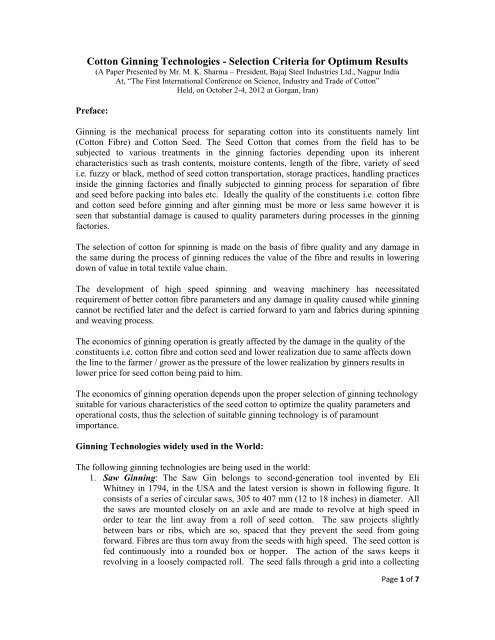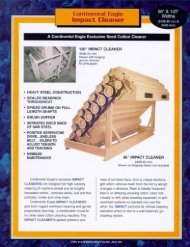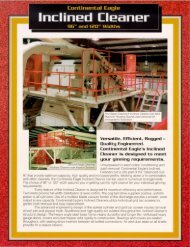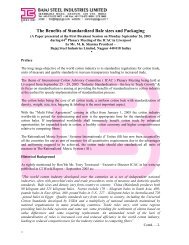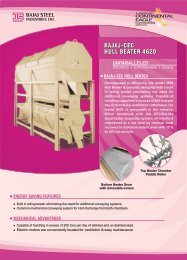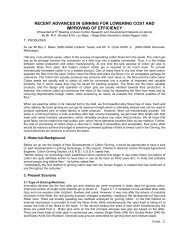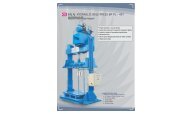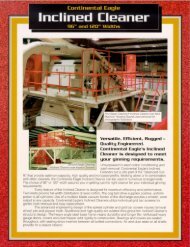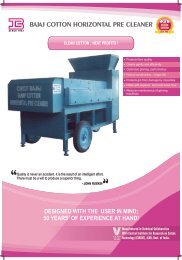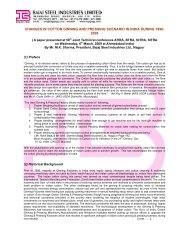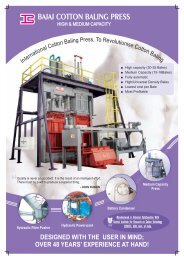Cotton Ginning Technologies - Selection Criteria for Optimum Results
Cotton Ginning Technologies - Selection Criteria for Optimum Results
Cotton Ginning Technologies - Selection Criteria for Optimum Results
You also want an ePaper? Increase the reach of your titles
YUMPU automatically turns print PDFs into web optimized ePapers that Google loves.
<strong>Cotton</strong> <strong>Ginning</strong> <strong>Technologies</strong> - <strong>Selection</strong> <strong>Criteria</strong> <strong>for</strong> <strong>Optimum</strong> <strong>Results</strong><br />
(A Paper Presented by Mr. M. K. Sharma – President, Bajaj Steel Industries Ltd., Nagpur India<br />
At, “The First International Conference on Science, Industry and Trade of <strong>Cotton</strong>”<br />
Held, on October 2-4, 2012 at Gorgan, Iran)<br />
Preface:<br />
<strong>Ginning</strong> is the mechanical process <strong>for</strong> separating cotton into its constituents namely lint<br />
(<strong>Cotton</strong> Fibre) and <strong>Cotton</strong> Seed. The Seed <strong>Cotton</strong> that comes from the field has to be<br />
subjected to various treatments in the ginning factories depending upon its inherent<br />
characteristics such as trash contents, moisture contents, length of the fibre, variety of seed<br />
i.e. fuzzy or black, method of seed cotton transportation, storage practices, handling practices<br />
inside the ginning factories and finally subjected to ginning process <strong>for</strong> separation of fibre<br />
and seed be<strong>for</strong>e packing into bales etc. Ideally the quality of the constituents i.e. cotton fibre<br />
and cotton seed be<strong>for</strong>e ginning and after ginning must be more or less same however it is<br />
seen that substantial damage is caused to quality parameters during processes in the ginning<br />
factories.<br />
The selection of cotton <strong>for</strong> spinning is made on the basis of fibre quality and any damage in<br />
the same during the process of ginning reduces the value of the fibre and results in lowering<br />
down of value in total textile value chain.<br />
The development of high speed spinning and weaving machinery has necessitated<br />
requirement of better cotton fibre parameters and any damage in quality caused while ginning<br />
cannot be rectified later and the defect is carried <strong>for</strong>ward to yarn and fabrics during spinning<br />
and weaving process.<br />
The economics of ginning operation is greatly affected by the damage in the quality of the<br />
constituents i.e. cotton fibre and cotton seed and lower realization due to same affects down<br />
the line to the farmer / grower as the pressure of the lower realization by ginners results in<br />
lower price <strong>for</strong> seed cotton being paid to him.<br />
The economics of ginning operation depends upon the proper selection of ginning technology<br />
suitable <strong>for</strong> various characteristics of the seed cotton to optimize the quality parameters and<br />
operational costs, thus the selection of suitable ginning technology is of paramount<br />
importance.<br />
<strong>Ginning</strong> <strong>Technologies</strong> widely used in the World:<br />
The following ginning technologies are being used in the world:<br />
1. Saw <strong>Ginning</strong>: The Saw Gin belongs to second-generation tool invented by Eli<br />
Whitney in 1794, in the USA and the latest version is shown in following figure. It<br />
consists of a series of circular saws, 305 to 407 mm (12 to 18 inches) in diameter. All<br />
the saws are mounted closely on an axle and are made to revolve at high speed in<br />
order to tear the lint away from a roll of seed cotton. The saw projects slightly<br />
between bars or ribs, which are so, spaced that they prevent the seed from going<br />
<strong>for</strong>ward. Fibres are thus torn away from the seeds with high speed. The seed cotton is<br />
fed continuously into a rounded box or hopper. The action of the saws keeps it<br />
revolving in a loosely compacted roll. The seed falls through a grid into a collecting<br />
Page 1 of 7
<strong>Cotton</strong> <strong>Ginning</strong> <strong>Technologies</strong> - <strong>Selection</strong> <strong>Criteria</strong> <strong>for</strong> <strong>Optimum</strong> <strong>Results</strong><br />
box or seed conveyor. The lint is whipped off the teeth of the saws by high-speed<br />
brushes or an air blast.<br />
Fig. Saw Gin<br />
The Saw <strong>Ginning</strong> Technology is normally used <strong>for</strong> short and medium staple cotton<br />
i.e. up to 28 mm and the plant designs developed so far in the world is keeping in<br />
view the machine picked cotton with higher trash contents and most of the cleaning<br />
equipments and feeders to the gins have been designed to handle high trash cotton<br />
however the fibre parameters get deteriorated in terms of neps, length and spinability<br />
parameters more particularly when any long or extra long fibre is ginned on Saw Gin.<br />
2. Roller Gins: The roller gins are classified as oscillatory knife gin and rotary knife gin<br />
depending upon the type of motion of moving knife. Oscillatory type gins are further<br />
classified as single roller (SR) and Double roller (DR) depending on the number of<br />
rollers used per machine.<br />
a) Single Roller Gin - McCarthy Gin<br />
The principle of working of single roller gin is popularly known as McCarthy<br />
principle named after its proponent and shown in Figure.<br />
Figure Single Roller Gin<br />
Page 2 of 7
<strong>Cotton</strong> <strong>Ginning</strong> <strong>Technologies</strong> - <strong>Selection</strong> <strong>Criteria</strong> <strong>for</strong> <strong>Optimum</strong> <strong>Results</strong><br />
It lies in picking and then moving the cotton fibres between the roller and fixed knife<br />
preventing the seeds to pass through. The seed cotton, when thrown into the hopper,<br />
passes through the machine. While the machine is working, at each elevation of the<br />
moving knife the grids lift the cotton to the level of the stationary knife-edge and of<br />
the exposed surface of the rollers. The free ends of the fibres are gripped, in the<br />
grooves of the rotating roller, and dragged <strong>for</strong>ward till the seeds reach the edge of<br />
stationary knife. The edge where the fibre is caught is the ginning point. By the<br />
downward motion of the moving knife, the seeds are detached from the cotton at the<br />
ginning point and are thrown out through the slots of the grid. It is important that the<br />
grooves of the rollers should be kept well open and when the leather roller becomes<br />
smooth, rough file should be applied occasionally to the surface to keep the same grip<br />
and pull on the fibre. The seeds are then hammered by means of the rapidly moving<br />
knife whereby some fibres are separated. In subsequent cycles, the remaining fibres<br />
also get separated. This process is continued till all the fibres from the seed get<br />
removed.<br />
The Single Roller McCarthy Gin technology is most suitable <strong>for</strong> handpicked, low<br />
trash cottons of medium, long and extra long staple length. This technology retains<br />
maximum natural fibre parameters of the cotton during the ginning hence treated best.<br />
b) Double Roller Gin<br />
Double Roller is the improved version of McCarthy Single Roller Gins. In a double<br />
roller (DR) gin, two spirally grooved leather rollers, pressed against two stationary<br />
knives with the help of adjustable dead loads, are made to rotate in opposite directions<br />
at a definite speed.<br />
Fig. Double Roller Gin machine with auto-feeder<br />
Page 3 of 7
<strong>Cotton</strong> <strong>Ginning</strong> <strong>Technologies</strong> - <strong>Selection</strong> <strong>Criteria</strong> <strong>for</strong> <strong>Optimum</strong> <strong>Results</strong><br />
The three beater arms (two at end and one at the centre of beater shaft) are inserted in<br />
the beater shaft and two knives (moving knives) are then fixed to the beater arms with<br />
proper alignment. This assembly is known as beater assembly, which oscillates by<br />
means of a crank or eccentric shaft, close to the leather roller. When the seed cotton is<br />
fed to the machine in action, fibres adhere to the rough surface of the roller and are<br />
carried in between the fixed knife and the roller such that the fibres are partially<br />
gripped between them. The oscillating knives (moving knives) beat the seeds from top<br />
and separate the fibres, which are gripped from the seed end. This process is repeated<br />
a number of times till all spin-able fibres are separated from the seeds, which are<br />
carried <strong>for</strong>ward on the roller and doffed out of the machine. The ginned seeds drop<br />
down through the slots provided on seed grid, which is part and parcel of beater<br />
assembly, which also oscillates along with the moving knives.<br />
This technology also retains maximum natural fibre parameters of the cotton similar<br />
to McCarthy Single Roller Gin but produces double or more quantity of fibre at same<br />
electrical power and processing cost hence most cost effective. There<strong>for</strong>e maximum<br />
McCarthy Single Roller Gins have been replaced by this technology in case of hand<br />
picked cotton. In Double Roller <strong>Ginning</strong> Technology one can gin all types of cotton<br />
of the world by simple setting adjustments, hence this technology has rapidly replaced<br />
majority of McCarthy Single Roller Gins and has become most preferred technology<br />
<strong>for</strong> hand picked cotton where trash contents are lower in the seed cotton.<br />
3. Rotobar Gin: The Rotobar gin is shown in Figure (a). It works on the same principle<br />
as the roller gin as shown in Figure (b). It has a rotating instead of oscillating beater<br />
bar, and is expected to give higher amount of lint per hour. The rotary knife vibrates<br />
less due to rotary motion and is more efficient than the reciprocating knife, which<br />
wasted time during backstroke. <strong>Ginning</strong> rate and carryover (unginned seed cotton that<br />
accompanies the seed) increase with feed rate. The main components of rotary knife<br />
roller gin stand include the stationary knife, rotary knife and ginning roller. The<br />
ginning roller is the most important and expensive component in the roller gin stand.<br />
Roller covering material is made from 13 layers of plain woven cotton fabrics<br />
cemented together with rubber compound.<br />
Rotary-knife roller gin stands separate fibre from seed by frictional <strong>for</strong>ces between a<br />
moving (roller) and fixed (stationary knife) surface. Three frictional <strong>for</strong>ces exist while<br />
roller ginning cotton: (i) roller-to- stationary knife (ii) roller-to-fibre and (iii)<br />
stationary knife- to-fibre. During normal ginning, the roller-to-fibre <strong>for</strong>ce is greater<br />
than the stationary knife- to-fibre <strong>for</strong>ce; there<strong>for</strong>e, the fibre sticks to the roller surface<br />
and slips to the stationary knife surface. Also, greater the <strong>for</strong>ce between the stationary<br />
knife and ginning roller, the greater the frictional pulling <strong>for</strong>ce between the fibre and<br />
ginning roller.<br />
Page 4 of 7
<strong>Cotton</strong> <strong>Ginning</strong> <strong>Technologies</strong> - <strong>Selection</strong> <strong>Criteria</strong> <strong>for</strong> <strong>Optimum</strong> <strong>Results</strong><br />
Figure Rotobar Gin and Principle of its operation<br />
<strong>Cotton</strong> is ginned at the rate the cotton fibres (adhered to the roller surface) slip under<br />
the stationary knife. Overfeeding or feeding in bunches causes fibre and seed to<br />
entangle with each other and ginning per<strong>for</strong>mance gets adversely affected.<br />
This Technology is mainly used <strong>for</strong> ginning of Pima cotton in the USA and other<br />
black seed cottons in other countries of the world however this technology is having<br />
disadvantages in the fuzzy seed cottons where unginned cotton going with seed and<br />
seed cuts are observed due to inherent technological reasons. There<strong>for</strong>e this could not<br />
find much place in the other countries where the cotton is hand picked and clean but<br />
Rotobar does not give better results on medium or short staple cotton.<br />
4. Market Share of Saw, Roller and Rotobar Gins: The market share of different gins<br />
depends upon socio-economic, agro-climatic conditions, the pattern of varieties<br />
grown in the country, harvesting methods, trash contents. Recently, there has been a<br />
switching from Saw <strong>Ginning</strong> to DR <strong>Ginning</strong> in the countries like; Zimbabwe,<br />
Tanzania, Malawi, Uganda, Zambia, Myanmar, Madagascar and Peru etc.<br />
Fig. Market Share of <strong>Ginning</strong> <strong>Technologies</strong><br />
Page 5 of 7
<strong>Cotton</strong> <strong>Ginning</strong> <strong>Technologies</strong> - <strong>Selection</strong> <strong>Criteria</strong> <strong>for</strong> <strong>Optimum</strong> <strong>Results</strong><br />
It is seen that Saw Gin holds about 50% world market share while Double Roller<br />
<strong>Ginning</strong> holds between 30-35%, Rotobar about 5% and McCarthy Single Roller about<br />
10%.<br />
The selection criteria <strong>for</strong> <strong>Ginning</strong> <strong>Technologies</strong><br />
Most of the people who want to start ginning factories do not have adequate knowledge about<br />
the ginning principles of various ginning technologies available in the world and they go<br />
primarily by the available machinery in their area without considering the correct requirement<br />
<strong>for</strong> the type of cotton available to them <strong>for</strong> ginning. This is many time resulting in avoidable<br />
loss of fibre and damage to fibres, finally resulting in lower realization of value.<br />
The primary criteria which should be considered be<strong>for</strong>e selecting any ginning technology<br />
may be summarized as below:<br />
1. Length of the fibre to be ginned.<br />
If the length of the fibre is above 28 mm it will not be beneficial to select Saw Gin as<br />
some damage in the fibre length is certainly going to take place, hence Double Roller<br />
or McCarthy Single Roller Gins should be necessarily used to obtain optimum results<br />
if fuzzy seed cotton is to be ginned. Double Roller Gin being cost effective the same<br />
are preferred over McCarthy Single Roller Gins. However <strong>for</strong> black seed cotton<br />
Double Roller or McCarthy Single Roller will give equally good results but Rotobar<br />
can also be used.<br />
2. Trash contents in the Seed <strong>Cotton</strong>:<br />
If the trash contents in the seed cotton are on the higher side either the additional<br />
cleaning equipments should be used or only Saw <strong>Ginning</strong> should be used as in other<br />
technologies the same will choke the seed clearance grid in McCarthy Single Roller<br />
Gin or Double Roller Gin while the Saw Gin will crush the leafy material and mix it<br />
with the lint which can be separated in saw type cleaner or similar devices. Hence <strong>for</strong><br />
the high trash machine picked seed cotton either additional cleaning equipments<br />
should be used be<strong>for</strong>e ginning or Saw Gins should be selected.<br />
3. Moisture Contents in Seed <strong>Cotton</strong>:<br />
If the moisture contents in the seed cotton are over 8% the Saw Gin should not be<br />
used to avoid any damage to the fibre. The Roller Gins can take up to 10-11%<br />
moisture but above that the drying process should be adopted be<strong>for</strong>e feeding the seed<br />
cotton to the ginning machines and the moisture contents should be brought down to<br />
below 10% be<strong>for</strong>e ginning.<br />
Page 6 of 7
<strong>Cotton</strong> <strong>Ginning</strong> <strong>Technologies</strong> - <strong>Selection</strong> <strong>Criteria</strong> <strong>for</strong> <strong>Optimum</strong> <strong>Results</strong><br />
4. Harvesting Practices:<br />
If the seed cotton is machine picked it is bound to have higher initial trash contents<br />
which should either be removed be<strong>for</strong>e feeding to gins or the saw gins in case of short<br />
and medium staple cotton or rotobar <strong>for</strong> long and extralong cotton should be used<br />
which have in built cleaner feeder however the best thing would be to remove the<br />
higher trash at the seed cotton stage only and then use the Double Roller or McCarthy<br />
Single Roller if used would give better fibre parameters.<br />
For the hand picked cotton where the trash contents are lower the Double Roller or<br />
McCarthy Single Roller Gin will give best fibre parameters i.e. lowest neps and<br />
highest fibre length but there are exceptions like in Pakistan though the cotton is hand<br />
picked but due to harvesting practices it is having very high trash, hence Saw Gin is<br />
widely used.<br />
5. Electrical Power Cost:<br />
It is seen that Double Roller <strong>Ginning</strong> Technology is most power effective i.e. <strong>for</strong> per<br />
unit of production lowest power consumption is required in case of Double Roller<br />
there<strong>for</strong>e the consideration <strong>for</strong> power cost per unit is also very important.<br />
Conclusion:<br />
With the introduction of fully automatic plants <strong>for</strong> all the ginning technologies in the world<br />
man power requirement <strong>for</strong> all of them is more or less similar, hence the ginning technology<br />
which is most suitable <strong>for</strong> the type of cotton available <strong>for</strong> ginning should be selected i.e. <strong>for</strong><br />
the black seed long and extra long staple cotton if it is clean McCarthy Single Roller or<br />
Double Roller should be selected but if it is machine picked / having higher trash then<br />
Rotobar should be used. For fuzzy seed cotton up to medium staple cotton if it is having<br />
higher trash Saw Gin set up should be used however if it is hand picked / clean Double Roller<br />
should be used to obtain best fibre parameters.<br />
*******<br />
Page 7 of 7


